Does Merida From Brave Always Wear a Dress
As the title implies, this post is about the historical accuracy of Disney Pixar'sBrave. I wrote a research paper on this topic several years ago, which was the primary reason why I made my Merida dress. I presented my research for school, and thought, "Hey, why not make a dress to go with it?"
I already posted all about my Merida dress (Part 1, Part 2, Part 3), and so this post will be all about my actual research.
So without further ado, here are my findings.
Many movies have been made about different periods in history. Each one of those movies has varying degrees of historical accuracy. Some are complete fantasy. Others are almost entirely historically accurate. And still others fall in the middle of that scale, containing historical accuracy mixed with fantasy. That is where Disney Pixar's 2012 animated film, Brave falls on the scale. Set in a kingdom in the highlands of medieval Scotland, Brave's fictional story is mixed with accurate costumes and sets as well as real themes and ideas that give the film a sense of believability.
According to co-director Mark Andrews, Brave takes place in 9th to 12th century Scotland. Andrews said, "We kind of looked at the 9th to the 12th century and took all the stuff that we liked and made a fantasy Scotland" (Andrews, thesudburystar.com).
The costumes worn by the women in Brave are very historically accurate. The rich, green dress worn by Queen Elinor, Merida's mother, is a great example of how a woman's dress reflected her social status and wealth. Elinor's dress is composed of at least two dress layers: a fitted under layer called a kirtle made of a dark green linen and an over-dress called a surcote made of a flowing silk-like fabric. Elinor's dark-green underdress (kirtle) has a fitted bodice with a full floor length skirt and long, fitted sleeves that come to her knuckles. Her over-dress (surcote) has a fitted bodice with buttons up the front, a full skirt with a long train, and flowing sleeves that almost reach the ground. The skirt has a slit up the front that reveals the dark green kirtle underneath. Surcotes were a huge sign of wealth in the Middle Ages. Fabric was very expensive, especially silk fabric which had to be imported from the East. The large amounts of fabric in the sleeves and train showed that Elinor was definitely part of nobility. The buttons on the front of her surcote were also a sign of wealth. In addition, Elinor wears a gold-colored metal belt around her waist. Richly made belts were also a sign of wealth and status (Gilbert). Elinor's hair is very long, almost floor length, and is worn parted in the middle, and wrapped with gold ribbons. During most of the Middle Ages, married women covered their hair with veils or later elaborate headdresses. However, during the 1100's after the Norman invasion, there was a short time when women wore their hair parted in the middle and excessively long hair was a common trend ("Jewels, Hair, and Accessories").
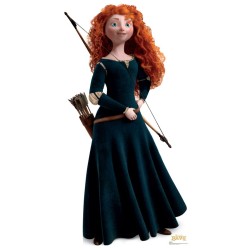 Merida wears two dresses throughout the film. Her first and primary dress is made up of a cream colored linen chemise and a dark blue wool kirtle that she wears on the top. Merida's dark blue overdress has slit sleeves that reveal the gathered cream colored underdress at her shoulders and elbows. The underdress is also visible at the bottom of the sleeves and around the neckline. Merida's fiery red hair is left loose, and she wears ankle-height brown leather shoes.
Merida wears two dresses throughout the film. Her first and primary dress is made up of a cream colored linen chemise and a dark blue wool kirtle that she wears on the top. Merida's dark blue overdress has slit sleeves that reveal the gathered cream colored underdress at her shoulders and elbows. The underdress is also visible at the bottom of the sleeves and around the neckline. Merida's fiery red hair is left loose, and she wears ankle-height brown leather shoes.
Linen was a very common fabric during the middle ages because it was comfortable when worn as the layer against the skin. Wool was also very common because it was warm during the cold winters. Linen was made from flax plants and wool was spun from sheep and sometimes goats. Leather was used to make shoes, pouches, and many other items as it was readily available.
 Merida's second dress is made of a sky blue satin or silk. It is the typical kirtle style with long fitted sleeves, a fitted bodice, and a flared skirt. The dress also has a gold panel around the hem as well as gold trim around the neckline and tips of the sleeves. Merida's wild hair is tamed in the form of a wimple, a cloth headpiece that covered the neck and hair. There has been some debate over whether or not Merida's wimple is historically accurate for the time period of the movie. Richard Oram, a Scottish historian said, "You can see the film-makers have done their homework, even if they've mixed up their periods a bit. So we get . . . high-status females wearing . . . wimples, as they would have done in the 14th and 15th centuries" (Oram). Merida also wears a tight corset underneath her light blue dress which has been a topic of high debate among historians and feminists. Tight laced corsets worn as undergarments weren't invented until the 1800's (Thomas). Corsets existed really only by name in the Middle Ages. What we believe was called a "corset" then was a long, loose garment that was simply pulled over the head and was not used to give shape to the body at all. Men as well as women wore them, but only those of nobility and great wealth, for they were decorated with expensive jewels and fur. Their decorations imply that the medieval "corset" was worn on top of clothing, not as an undergarment. Not much more detail is known about corsets in the Middle Ages, but we do know that the "corset" Merida wears is very inaccurate.
Merida's second dress is made of a sky blue satin or silk. It is the typical kirtle style with long fitted sleeves, a fitted bodice, and a flared skirt. The dress also has a gold panel around the hem as well as gold trim around the neckline and tips of the sleeves. Merida's wild hair is tamed in the form of a wimple, a cloth headpiece that covered the neck and hair. There has been some debate over whether or not Merida's wimple is historically accurate for the time period of the movie. Richard Oram, a Scottish historian said, "You can see the film-makers have done their homework, even if they've mixed up their periods a bit. So we get . . . high-status females wearing . . . wimples, as they would have done in the 14th and 15th centuries" (Oram). Merida also wears a tight corset underneath her light blue dress which has been a topic of high debate among historians and feminists. Tight laced corsets worn as undergarments weren't invented until the 1800's (Thomas). Corsets existed really only by name in the Middle Ages. What we believe was called a "corset" then was a long, loose garment that was simply pulled over the head and was not used to give shape to the body at all. Men as well as women wore them, but only those of nobility and great wealth, for they were decorated with expensive jewels and fur. Their decorations imply that the medieval "corset" was worn on top of clothing, not as an undergarment. Not much more detail is known about corsets in the Middle Ages, but we do know that the "corset" Merida wears is very inaccurate.
The production team for Brave spent numerous hours researching the Scottish landscape. The team took two trips to Scotland to help really capture the look and feel of Scotland in the film. Co-director Katherine Sarafian said, "Every Pixar film, we do our research. In our case, we went to Scotland twice, and we went way, way deep in . . . we wanted this character in the movie of Scotland." Scottish historian Richard Oram said of Brave:
I'm a keen hill-walker, as well as an environmental historian, and I kept seeing places I recognized: in an early scene, the main character, Merida, scales a rocky outcrop that's 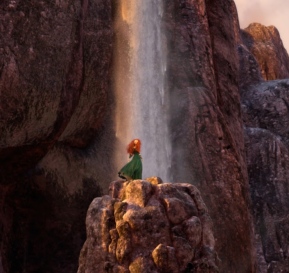 clearly modeled on Cairngorm granite, right down to the color and texture . . .The general feel – the mix of water and hills, forest and mountains – is very good: the forests are a realistic blend of Scots pine and birch (Oram).
clearly modeled on Cairngorm granite, right down to the color and texture . . .The general feel – the mix of water and hills, forest and mountains – is very good: the forests are a realistic blend of Scots pine and birch (Oram).
One notable inaccuracy of the landscape in Brave is the fire falls that Merida climbs toward the beginning of the film. These falls may be the "rocky outcrop" that Richard Oram mentions in the quote above. Co-director Mark Andrews said that, "The fire falls in the movie–there are no fire falls in Scotland, but there are fire falls at Yosemite National Park. It actually happens" (Andrews, veryaware.com). So even though the falls don't exist in Scotland itself, they are based on a real place.
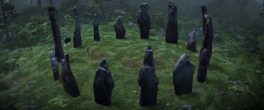 A recurring landmark seen in Brave is particular circle of rocks located in the woods around Merida's castle. The rock formation is formally called a stone circle. Stone circles are made of large pieces of stone that have been cut and planted upright in the ground in a circle formation. Around one thousand three hundred stone circles and henges exist in Britain (including Scotland) and Ireland in various sizes ("Odyssey"). Their original purpose is unknown, and many legends surround the stone circles. Some of the most famous stone circles are on the Orkney Islands, found off the north coast of Scotland.
A recurring landmark seen in Brave is particular circle of rocks located in the woods around Merida's castle. The rock formation is formally called a stone circle. Stone circles are made of large pieces of stone that have been cut and planted upright in the ground in a circle formation. Around one thousand three hundred stone circles and henges exist in Britain (including Scotland) and Ireland in various sizes ("Odyssey"). Their original purpose is unknown, and many legends surround the stone circles. Some of the most famous stone circles are on the Orkney Islands, found off the north coast of Scotland.  Orkney's Ring o'Brodgar and the Standing Stones o' Stenness are two of the most famous stone circles on the Orkney Islands. The Ring o'Brodgar is believed to have been built around 2500 BC to 2000 BC and is around three hundred and forty-one feet wide. It is believed to have originally contained one hundred and sixty stones, though now only twenty-seven stones remain (Towrie). In his book, Around the Orkney Peat-Fires, William Mackintosh describes the Stones o' Stenness in this way: "Even in daylight the place has something uncanny about it. The Standing Stones o' Stenness, mouldering, scarred and grey with age, rising as they do from and unbroken bed of heather always have a weird mysterious appearance." This description fits with the feel of the stone circle in Brave and explains why Merida's horse, Angus, was so startled by the stones that he threw Merida off his back.
Orkney's Ring o'Brodgar and the Standing Stones o' Stenness are two of the most famous stone circles on the Orkney Islands. The Ring o'Brodgar is believed to have been built around 2500 BC to 2000 BC and is around three hundred and forty-one feet wide. It is believed to have originally contained one hundred and sixty stones, though now only twenty-seven stones remain (Towrie). In his book, Around the Orkney Peat-Fires, William Mackintosh describes the Stones o' Stenness in this way: "Even in daylight the place has something uncanny about it. The Standing Stones o' Stenness, mouldering, scarred and grey with age, rising as they do from and unbroken bed of heather always have a weird mysterious appearance." This description fits with the feel of the stone circle in Brave and explains why Merida's horse, Angus, was so startled by the stones that he threw Merida off his back.
 Merida's family's castle is quite historically accurate in the way it was designed. The walls are made of stone with wooden doors. Stone castles replaced castles that were entirely made of wood in the 12th century.The stable where Merida keeps her horse, Angus, is located inside the castle walls, but not inside the castle living space. The majority of stables in medieval castles were kept inside the walls so they were protected in the event of an attack.
Merida's family's castle is quite historically accurate in the way it was designed. The walls are made of stone with wooden doors. Stone castles replaced castles that were entirely made of wood in the 12th century.The stable where Merida keeps her horse, Angus, is located inside the castle walls, but not inside the castle living space. The majority of stables in medieval castles were kept inside the walls so they were protected in the event of an attack.
The first room inside the castle gate is the great room. The great room is lit by natural light by day and candles and torches by night, as it would have been in the Middle Ages. The walls are adorned with tapestries and stone carvings. The great room serves as the throne room, dining room, and entertainment room when needed. At dinner time, a large table is brought into the great room and Merida's family eats around the table together, each with their own chair. When the three clans visit the castle, multiple tables and benches are brought into the room to seat the many guests. In the middle ages, only the nobility used chairs, and benches were much more common (Gravett 43). Thus, the bench seating for the clan guests is accurate.
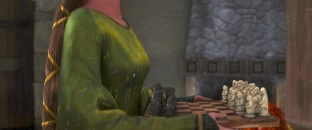 A set of stairs in Merida's castle leads to the bedrooms and family room. Merida's bedroom as well as the master bedroom both contain fireplaces, candles, and torches for light in the evenings. The rooms are sparsely furnished with wooden chests and four-poster beds. Likewise, the family room has a fireplace and wood furniture. Family rooms were common in the Middle Ages as a place for the family to gather for storytelling, music, playing chess and many other activities. Chess was a very popular game among both peasants and nobility (Dixon 18). In Brave, we also see Elinor stitching her tapestries in the family room. Making tapestries as well as embroidery and music were extremely common pastimes for noble women in the Middle Ages.
A set of stairs in Merida's castle leads to the bedrooms and family room. Merida's bedroom as well as the master bedroom both contain fireplaces, candles, and torches for light in the evenings. The rooms are sparsely furnished with wooden chests and four-poster beds. Likewise, the family room has a fireplace and wood furniture. Family rooms were common in the Middle Ages as a place for the family to gather for storytelling, music, playing chess and many other activities. Chess was a very popular game among both peasants and nobility (Dixon 18). In Brave, we also see Elinor stitching her tapestries in the family room. Making tapestries as well as embroidery and music were extremely common pastimes for noble women in the Middle Ages.
 One slight inaccuracy in the castle design is the use of glass. Glass in the Middle Ages was very expensive, and thus was used very sparsely in castles. Merida's bedroom has a relatively large glass window with ironwork in front of the glass. The family room and master bedroom both have three long, rectangular windows with glass panes and ironwork. The long rectangular style window was much more likely to have been used than one large window like
One slight inaccuracy in the castle design is the use of glass. Glass in the Middle Ages was very expensive, and thus was used very sparsely in castles. Merida's bedroom has a relatively large glass window with ironwork in front of the glass. The family room and master bedroom both have three long, rectangular windows with glass panes and ironwork. The long rectangular style window was much more likely to have been used than one large window like  Merida's, however there is no reason that larger windows wouldn't have existed. In the film, there is also a small window with glass in the door to the family room. This window is used to tell the story of the film several times during the movie, however in reality, glass would have likely been too expensive a commodity to have been used on a door.
Merida's, however there is no reason that larger windows wouldn't have existed. In the film, there is also a small window with glass in the door to the family room. This window is used to tell the story of the film several times during the movie, however in reality, glass would have likely been too expensive a commodity to have been used on a door.
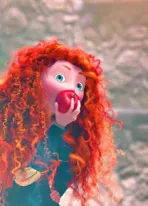 The food eaten in Brave is accurate for what would have been eaten in medieval Scotland. Multiple times during the film, we can see Merida eating apples. Fruit, such as apples, pears, and cherries, were very commonly eaten and grown in orchards outside the castles. During the family dinner scene, Merida's little brothers were complaining about eating Haggis, a type of pudding that was cooked in sheep stomach lining and mixed with spices, onions, oatmeal, and suet, which is a type of animal fat. On the website iGourmet.com, Haggis is described as "a national culinary icon in Scotland."
The food eaten in Brave is accurate for what would have been eaten in medieval Scotland. Multiple times during the film, we can see Merida eating apples. Fruit, such as apples, pears, and cherries, were very commonly eaten and grown in orchards outside the castles. During the family dinner scene, Merida's little brothers were complaining about eating Haggis, a type of pudding that was cooked in sheep stomach lining and mixed with spices, onions, oatmeal, and suet, which is a type of animal fat. On the website iGourmet.com, Haggis is described as "a national culinary icon in Scotland."
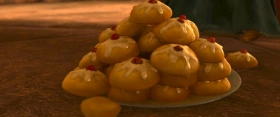 Merida and her brothers are seen several times throughout the film trying to steal a type of sweet cookie with icing and jam on the top. Recipes for these cookies, called "tipperary biscuits," are still around today (allrecipes.com). During the dinner scene, King Fergus is shown eating a type of cooked meat. Meat from all sorts of birds and animals were eaten in medieval Scotland, including beef, mutton, and sometimes venison if it was caught on a recent hunt. Fish were also a very common meat in Scotland. Herring, pike, bream, and salmon were all common types of fish ("Scotland's History"). The abundance of salmon in the stream that Merida catches with Elinor would have been highly likely. Today, Scotland is one of the top exporters of salmon.
Merida and her brothers are seen several times throughout the film trying to steal a type of sweet cookie with icing and jam on the top. Recipes for these cookies, called "tipperary biscuits," are still around today (allrecipes.com). During the dinner scene, King Fergus is shown eating a type of cooked meat. Meat from all sorts of birds and animals were eaten in medieval Scotland, including beef, mutton, and sometimes venison if it was caught on a recent hunt. Fish were also a very common meat in Scotland. Herring, pike, bream, and salmon were all common types of fish ("Scotland's History"). The abundance of salmon in the stream that Merida catches with Elinor would have been highly likely. Today, Scotland is one of the top exporters of salmon.
 The most obvious inaccuracy with regards to food and meals in Brave is the use of forks. The movie shows the table set with three-pronged forks, however forks were not used in the Middle Ages. Spoons and knives were used, but forks were unknown at that time.
The most obvious inaccuracy with regards to food and meals in Brave is the use of forks. The movie shows the table set with three-pronged forks, however forks were not used in the Middle Ages. Spoons and knives were used, but forks were unknown at that time.
Legends play a big role in the story of Brave. Merida states in the opening of the movie that, "The story of how [her] father lost his leg to the demon bear Mordu became legend." Queen Elinor gives Merida lesson on selfishness in the form of a legend about an ancient kingdom. Merida's lackadaisical attitude about the legend prompts Elinor to respond that, "Legends are lessons, they ring with truths."
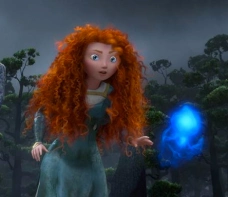 Two important themes and ideas in Brave stemmed from Scottish legends and mythology. The magical "Will o' the Wisps" are rooted in Celtic legends as well as scientific reality. Co-director Mark Andrews sums it up best in an interview. He said,
Two important themes and ideas in Brave stemmed from Scottish legends and mythology. The magical "Will o' the Wisps" are rooted in Celtic legends as well as scientific reality. Co-director Mark Andrews sums it up best in an interview. He said,
The will o' the wisps are in a lot of Scottish folklore. They were said to lead you to treasure or doom–to change your fate– but they're an actual phenomenon of swamp and bog gas seeping up through the earth and interacting with the natural resources to create the blue flames. People would follow these lights thinking they were little fairies, and basically drown or get sucked down into the bogs. [So] we made the wisps like actual little spirits (Andrews).
 Even the ideas of the evil bear Mordu and Queen Elinor's transformation into a bear originated from Celtic mythology. Director Mark Andrews said, "I think the bear aspect . . . there's all these things in Celtic mythology about transformation into animals, so that was something that we pulled from and put into the film" (Andrews, veryaware.com).
Even the ideas of the evil bear Mordu and Queen Elinor's transformation into a bear originated from Celtic mythology. Director Mark Andrews said, "I think the bear aspect . . . there's all these things in Celtic mythology about transformation into animals, so that was something that we pulled from and put into the film" (Andrews, veryaware.com).
Girls didn't attend school in the Middle Ages since an education was not important for women during that time. Girls of nobility were taught how to sew, spin thread, and weave fabric. They were also taught correct manners and proper behavior.
The movie's focus on a headstrong female character would more than likely have been accurate in Scotland. Scottish historian Richard Oram says, "The fact that the film has a strong woman at its centre may be quite accurate: we know very little about women in medieval Scotland, but those we do know about seem to have been pretty feisty." Merida's betrothal to one of the three lord's sons is also a large theme of Brave. In the Middle Ages, marriages were very often arranged for monetary gain. A noble woman's family usually gave a dowry of land to their daughter's spouse, so who a man married was  a big deal (Amt). Young Dingwall, son of one of the three lords, said in the film (of the arranged marriage), "Why shouldn't we choose?", his father's response was, "But she's the princess!" At this, young Dingwall commented back to his father that he "didn't pick her out, it was [his father's] idea." A woman could marry at the age of twelve, and boys could marry at the age of fourteen (Macdonald 24), thus Merida's betrothal while she was a teenager was not uncommon.
a big deal (Amt). Young Dingwall, son of one of the three lords, said in the film (of the arranged marriage), "Why shouldn't we choose?", his father's response was, "But she's the princess!" At this, young Dingwall commented back to his father that he "didn't pick her out, it was [his father's] idea." A woman could marry at the age of twelve, and boys could marry at the age of fourteen (Macdonald 24), thus Merida's betrothal while she was a teenager was not uncommon.
Merida's reluctance to marry makes sense. Once a woman was married, she took on all the responsibilities of a wife. In the Middle Ages, "marriage was a full time job. A wife had to help her husband run his business or manage his land while he was away." A woman in medieval Scotland could refuse an arranged marriage if she had the courage to do so (Scott), however such an act was seen as selfish. Co-director Mark Andrews said, "You had this very traditional society that she wants to break with and find her own sense of person, so by having her mother, i.e. society, be in her way of what she's not ready to accept yet, she gets a little selfish and she gets desperate" (Andrews, veryaware.com).
Though we can see why Merida might have wanted to retain her freedom, her refusal to marry was also a refusal to accept responsibility. A refusal to grow up and do what many women before her had done. She selfishly and stubbornly insisted on living at home and was willing to go to great lengths to get her way. The movie makes the viewer sympathize with Merida and view Queen Elinor as a mother unwilling to listen to her daughter, when in reality, Merida was the one at fault.
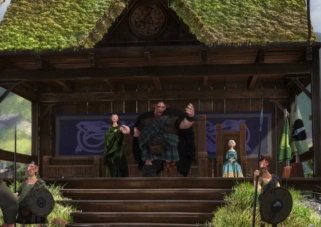 One thing that I didn't have in my paper but discussed in my presentation is a particular symbol. There is a symbol, I assume one that represents Clan DunBronch, that combines a celtic knot pattern with a bear. You can see it a little bit behind Merida and her family during the scene at the Highland Games, and it is also the design on the hem of Merida's skirt at the very end of the movie and in the Disney Parks.
One thing that I didn't have in my paper but discussed in my presentation is a particular symbol. There is a symbol, I assume one that represents Clan DunBronch, that combines a celtic knot pattern with a bear. You can see it a little bit behind Merida and her family during the scene at the Highland Games, and it is also the design on the hem of Merida's skirt at the very end of the movie and in the Disney Parks.
An artist's rendering of Merida's dress at the end of the movie where you can clearly see the bear design on the hem.
" data-medium-file="https://apprenticeofthechosenone.files.wordpress.com/2015/01/merida-vis-dev-brave-e1422594671815.jpg?w=300" data-large-file="https://apprenticeofthechosenone.files.wordpress.com/2015/01/merida-vis-dev-brave-e1422594671815.jpg?w=656" class="wp-image-562" src="https://apprenticeofthechosenone.files.wordpress.com/2015/01/merida-vis-dev-brave.jpg?w=359&h=400" alt="An artist's rendering of Merida's dress at the end of the movie where you can clearly see the bear design on the hem." width="359" height="400">While researching, I came across an 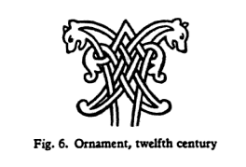 online eBook that had this symbol in one of its preview pages as shown at the right, and I was shocked at it's resemblance to the symbol inBrave. I don't know if the filmmakers knew this symbol existed while they were making the movie, but regardless, it just adds one more tiny historically accurate detail.
online eBook that had this symbol in one of its preview pages as shown at the right, and I was shocked at it's resemblance to the symbol inBrave. I don't know if the filmmakers knew this symbol existed while they were making the movie, but regardless, it just adds one more tiny historically accurate detail.
So that's what I have for you! I hope it was enlightening, or at least showed you maybe one or two things you didn't know about Medieval history! I was truly amazed at how accurate even some of the tiniest details of the movie turned out to be! Disney Pixar's Brave is filled with numerous historically accurate details, from the costumes and setting to the themes and ideals. Though it contains a few inaccuracies for the sake of storytelling, Brave's overall historical feel makes the viewer feel as if they are really in historical Scotland. The research completed by the producers before creating Brave is especially evident through the amount of historically accurate detail portrayed in the film. So even though Brave is historical fantasy, you can learn a great deal about life in Medieval Scotland by watching the film.
Hope you enjoyed it!
Taria
"Hard work does not necessarily guarantee success, but no success is possible without hard work."
Dr. T. P. Chia
Bibliography
Amt, Emilie. Women's Lives in Medieval Europe. New York: Routledge, 1993.
Andrews, Mark. Interview by Bruce Kirkland. "Brave Accurate, Just Not Historically." The Sudbury Star. 25 June 2012. <http://thesudburystar.com/2012/06/25.brave-accurate-just-not-historically>. (25 Feb. 2014).
Andrews, Mark and Brenda Chapman. Interview. "Scottish Story of 'Brave' Springs from Reality." <http://movies.inquirer.net/?p=5204>. (4 March 2014).
Andrews, Mark and Katherine Sarafian. Interview by Courtney Howard. "BRAVE's Katherine Sarafian & Mark Andrews Talk Technique, Inspiration, & Strong Heroines." Very Aware: The Movie Blog. 21 June 2012. <http://veryaware.com/2012/06/interview>. (24 Feb. 2014).
Dixon, Philip. Knights & Castles. Sydney: Weldon Owen Inc., 2009.
Ford, David Nash. "Early Kingdoms of Scotland." Early British Kingdoms. 2001. <http:// http://www.earlybritishkingdoms.com/adversaries/kingdoms/scot498.html>. (25 Feb. 2014).
Gilbert, Rosalie. "Rosalie's Medieval Woman." 2003. <http://rosaliegilbert.com/index.html>. (10 March 2014).
Gravett, Christopher. Castle. New York: Alfred A Knopf, Inc., 1994.
"Jewels, Hair, and Accessories of the Middle Ages." 21 Sept. 2011. <http://sites.tufts.edu/ putajewelonit/2011/09/21/glossary-of-english-hairstyles-headdresses/>. (24 Feb. 2014).
Macdonald, Fiona. First Facts About the Middle Ages. New York: Peter Bedrick Books, 1997.
Mackintosh, William R. Around the Orkney Peat-Fires. <http://www.orkneyjar.com/history/standingstones/index.html>. 24 Feb. 2014).
Oram, Richard. Interview by Laura Barnett. "A Scottish Historian on Brave." The Guardian. 30 August 2012). <http://www.theguardian.com/film/2012/aug/29/scottish-historian-view -brave>. (24 Feb. 2014).
"Scotland's History: Food and Drink." Education Scotland. <http://www.educationscotland.gov.uk/scotland'shistory/medievallife/foodanddrink/index.asp>. (24 Feb. 2014).
Scott, Amanda. "Women's Rights in Medieval Scotland." The Medieval Chronicle. August 2010. <http://www.themedievalchronicle.com/septoct01/Women_Rights_Scotland_JulyAug 2010.html>. (25 Feb. 2014).
"Scottish Food." igourmet.com. <http://www.igourmet.com/scottishfood.asp>. (24 Feb. 2014).
'Stone Circles of Scotland." Odyssey: Adventures in Archaeology. <http://www.odyssey adventures.ca/articles/stone-circles/article_stonecircles.htm>. (24 Feb. 2014).
Thomas, Pauline Weston. "Stays to Corsets–Fashion History." Fashion-Era. <http:// http://www.fashion-era.com/stays_to_corsets.htm> (10 March 2014).
Towrie, Siguard. "Orkney's Standing Stones." Orkneyjar: The Heritage of the Orkney Islands. <http://www.orkneyjar.com/history/monoliths/index.html>. (24 Feb. 2014).
Walker, Jane. 100 Things You Should Know about Knights and Castles. Essex: Miles Kelly Publishing, 2001.
Williams, Brenda and Brian. World Book looks at The Age of Knights and Castles. Chicago: World Book, Inc., 1996.
Source: https://apprenticeofthechosenone.wordpress.com/2015/08/23/disney-pixars-brave-historically-accurate/
0 Response to "Does Merida From Brave Always Wear a Dress"
Post a Comment